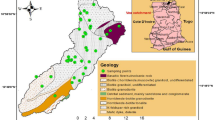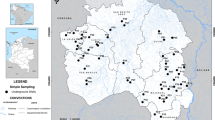Abstract
This investigation assesses the feasibility of calculating and visualizing health risk estimates from exposure to groundwater contaminated with arsenic (As) using data from national geochemical databases. The potential health risk associated with As-contaminated groundwater was assessed based on an elaboration of existing geochemical data in accordance with accepted methodological procedures established for human health risk assessment (U.S. Environmental Protection Agency methodology). A screening analysis approach was used for estimating the contribution of As to the total chronic health risk from exposure to groundwater contaminated with potentially toxic elements, including As, Ba, Cd, Cu, Hg, Pb, Sb, Se and Zn, and the results indicate that As contributes significantly (>50%) to this total health chronic risk in about 10% of Slovak territory. Based on the calculation of the potential risk level by exposure modelling, increased chronic as well as carcinogenic risk levels (medium to high) were documented in approximately 0.2 and 11% of the total Slovak area, respectively. The areas characterized by high health risk levels are mainly those geogenically contaminated. High and very high carcinogenic risk was determined in 34 of 79 districts and in 528 of 2924 municipalities.




Similar content being viewed by others
References
Ahmed, K. M., Bhattacharya, P., Hasan, M. A., Akhter, S. H., Mahbub Alam, S. M., Hossain Bhuyian, M. A., Badrul Imam, M., Khan, A. A. & Sracek, O. (2004) Arsenic enrichment in groundwater of the alluvial aquifers in Bangladesh: an overview. Applied Geochemistry, 19, 181–200.
Bundschuh, J., Farias, B., Martin, R., Storniolo, A., Bhattacharya, P., Cortes, J., Bonorino, G. & Albouy, R. (2004) Groundwater arsenic in the Chaco-Pampean plain, Argentina: case study from Robles county, Santiago del Estero province. Applied Geochemistry, 19, 231–243.
Cabrera, H. N., & Gómez, M. L. (2003) Skin cancer induced by arsenic in the water. Journal of Cutaneous Medicine and Surgery 7, 106–111.
Fletcher, T., Vahter, M., Goessler, W., Hemminki, K., Rudnai, P., Gurzau, E. & Koppova, K. (2003) Arsenic health risk assessment and molecular epidemiology. QLTR-2001–00264, Quality of life and Management of living resources, Second progress report on the period 1, Manuscript, 31.
Focazio, M. J., Welch, A. H., Watkins, S. A., Helsel, D. R. & Horn, M. A. (1999) A retrospective analysis on the occurrence of arsenic in groundwater resources of the United States and limitations in drinking-watersupply characterizations. Water-Resources Investigations Report, United States Geological Survey, 21.
Guo, H. R. & Tseng, Y. Ch. (2000) Arsenic in drinking water and bladder cancer: comparison between studies based on cancer registry and death certificates. Environmental Geochemistry and Health, 22, 83–91.
Khun, M., Jurkovič, Ľ, & Urminská, J. (2000) A brief outline of the problems and practical application in the region of Žiarska kotlina basin. Slovak Geological Magazine, 6(1), 17–26.
Lin, N. F., Tang, J., & Bian, J. M. (2002) Characteristic of environmental geochemistry in the arseniasis area of the Inner Mongolia of China. Environmental Geochemistry and Health, 24, 249–259.
RAIS – Risk Assessment Information System. www.risk.lsd.ornl.gov, http://www.risk.lsd. ornl.gov/ tox/latest.nonrad.xls.
Rapant, S., Cicmanová, S., Dietzová, Z., & Khun, M. (2003) Medical geology research in Slovakia, it´s background, methodology and preliminary results. Krystalinikum, 29, 61–70.
Rapant, S. & Kordík, J. (2003) An environmental risk assessment map of the Slovak Republic: Application of data from Geochemical Atlases. Environmental Geology, 44(4), 400–407.
Rapant, S., Vrana, K., & Bodiš, D. (1996) Geochemical atlas of Slovak Republic, Part I: Groundwater. GS SR, Bratislava, 127.
Rapant, S., Vrana, K., & Čurlík, J. (2004) Environmental risk from contamination of geological compartments of the environment of the Slovak Republic. GS SR, Bratislava, 80.
Smith, A. H., Lingas, E. O., & Rahman, M. (2000) contamination of drinking water by arsenic in Bangladesh: a public health emergency. Bulletin of the World Health Organisation, 78, 1093–1103.
Spence, L. R. & Walden, T. (2001) Risk-Integrated software for clean-ups - version RISC 4 . User´s manual, Spence Engineering, Pleasanton, California / BP Oil International, Sunbury UK.
Tollestrup, K., Frost, F. J., Cristiani, M., McMillan, G. P., Calderon, R. L., & Padilla, R. S. (2005) Arsenic-induced skin conditions identified in southwest dermatology practises: an epidemiologic tool? Environmental Geochemistry and Health, 27, 47–53.
U.S. EPA (1989) Risk assessment guidance for Superfund (RAGS): Volume I - Human health evaluation manual (HHEM), part A: Baseline risk assessment, Interim Final (EPA/540/1-89/002). United States Environmental Protection Agency, Office of Emergency and Remedial Response, Washington, D.C.
U.S. EPA (1998) Arsenic, inorganic, (CASRN 7440-38-2). United States Environmental Protection Agency, Integrated Risk Information System (IRIS), http://www.epa.gov/iris/ subst /0278.htm.
U.S. EPA (1999) A Risk Assessment – Multiway exposure spreadsheet calculation tool. United States Environmental Protection Agency, Washington, D.C.
Van Geen, A., Ahsan, H., Horneman, A. H., Dhar, R. K., Zheng, Y., Hussain, I., Ahmed, K. M., Gelman, A., Stute, M., Simpson, H. J., Wallace, S., Small, Ch., Parvez, F., Slavkovich, V., Lolacono, N. J., Becker, M., Cheng, Z., Momotaj, H., Shahnewaz, M., Seddique, A. A., & Graziano, J. H. (2002) Promotion of well-switching to mitigate the current arsenic crisis in Bangladesh. Bulletin of the World Health Organization, 80, 732–737.
WHO (1993) Guidelines for drinking water quality. Vol.1. Recommendations, Second Edition, World Health Organisation, Geneva.
Author information
Authors and Affiliations
Corresponding author
Rights and permissions
About this article
Cite this article
Rapant, S., Krčmová, K. Health risk assessment maps for arsenic groundwater content: application of national geochemical databases. Environ Geochem Health 29, 131–141 (2007). https://doi.org/10.1007/s10653-006-9072-y
Published:
Issue Date:
DOI: https://doi.org/10.1007/s10653-006-9072-y




